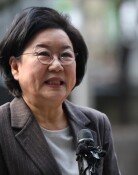Government to Develop Land In South Koreas Six Largest Cities
Government to Develop Land In South Koreas Six Largest Cities
Posted April. 01, 2005 23:26,
The government will re-develop 51,000 pyong (Korean measurement: about 170,000m2) of state land in metropolitan areas including Seoul, Busan, and the six largest cities into complex commercial zones comprising public institutions and private facilities.
It has also decided to make field inspections on 520 million pyong (about 1.713 billion m2) of nationwide state land by 2007 and select additional development targets.
Opening a coordination meeting of economic policies chaired by Deputy Prime Minister and Minister of Finance and Economy Han Duck-soo at the government complex located in Gwacheon yesterday, the government finalized its reform plan for state land management as described above.
Director Lee Chul-hwan of the Treasury Bureau of the Ministry of Finance and Economy stated, Among state lands, land that can be developed amounts to 55 cases, or 51,000 pyong. We plan to develop state land that seems to have good locations and that has good prospects for returns first as an example.
The state land that the government has decided to develop is land that the government received in lieu of tax revenue from those who did not pay their taxes. They are virtually idle lands.
Among the lands that the Finance and Economy Ministry owns, 140.9 million pyong can be classified as idle lands with their management rights delegated to local autonomous entities.
In terms of regions, Gangwon Province has the idlest land-31.86 million pyong-followed by Gyeonggi (21.9 million), South Jeolla (16.28 million), South Gyeongsang (14.46 million), South Chungcheong (11.77 million), North Gyeongsang (11.57 million), and North Jeolla (10.96 million).
The government has judged that metropolitan state land for non-administration use will have high returns once it develops it because the rent demand is strong.
As the first step, the government plans to develop the following areas as an example: Wolpyeong-dong, Seo-gu, Daejeon (6,000 pyong); Jeo-dong Ilga (Avenue Number One), Jung-gu, Seoul (1,297 pyong); and Gasan-dong, Geumcheon-gu, Seoul (86 pyong).
On the land in Wolpyeong-dong, the Statistical Training Institute, Ministry of Patriots and Veterans Affairs, Korea Food and Drug Administration, and other government-related agencies and private buildings will be set up.
The land in Jeo-dong is where the Namdaemun District Tax Office is located. Although its legal capacity ratio (buildings aggregate area to land area) is 600 percent, the 1926 built buildings capacity ratio is only 58 percent, thus it will be profitable to develop it. Taking into account the 600 percent capacity ratio, the government will build a building that has 3 and 15 floors below and above the ground, respectively.
Regarding the Gasan-dong land, the government plans to develop it for general commercial use since no government agency wants to move in there.
legman@donga.com







